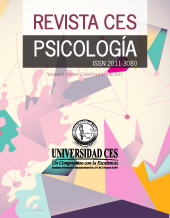Standardization of a Protocol of Neuropsychological Tests for the Assessment of Attention in College Students
DOI:
https://doi.org/10.21615/cesp.12.1.2Keywords:
Attention, Young Adults, Neuropsychological AssessmentAbstract
Objective: This study aimed to describe the results of a standardization study of some classical neuropsychological tasks for attention assessment: Trail Making Test A, B, Paced auditory serial addition test (PASAT). Methodology: The sample consisted of 208 healthy college students from Manizales, with no associated neurological or psychiatric pathology. The instruments used were the Rey verbal auditory learning test, the Rey complex test, the serial auditory test Pattern and Benton visual retention test. Analysis Plan: the validity of appearance was assessed through expert judgment, the content was evaluated by factorial analysis, the validity of concurrent criterion through the Pearson´s correlation coefficient, and the internal consistency by Cronbach's alpha coefficient. Consistency related to the time of the instrument administration by different evaluators, was analyzed according to the number of hits, the difference of means, and the correlation coefficient. The data consistency was analyzed by means of the Shapiro Wilk test. The male and female scores were collated by the U of Mann - Whitney or Student's t, and finally the scores obtained by each one of the tests were included in the research. Results: It was evidenced adequate content validity for the attentional tasks included in the study, as well as suitable criterion validity and reliability for the PASAT test, and low criterion validity and moderate levels of pretest, posttest reliability in the case of TMT (A) and TMT (B) tasks provided by the university student sample considered in the study.
Downloads
References
Ardila, R. (1998). Homosexualidad y psicología. Bogotá, Colombia: Manual Moderno.
Barrientos, J. & Cárdenas, M. (2013). Homofobia y Calidad de Vida de Gay y Lesbianas: Una Mirada Psicosocial.[Versión electrónica], Psykhe 22 (1), 3-14.
Ceballos, A., Zambrano, C. & Ojeda, E. (2012). Manual de orientaciones estratégicas para el empoderamiento en personas con orientacion sexual homosexual. San Juan de Pasto, Colombia: CEPUN.
Ceballos, M. (2014). Identidad homosexual y contexto familiar heteroparental: implicaciones educativas para la subversión social.[Versión electrónica],Revista latinoamericana ciencias sociales niñez juventud 12 (2), 643-658.
Costa, P., Pereira, H. & Leal, I. (2013). Internalized Homonegativity, Disclosure, and Acceptance of Sexual Orientation in a Sample of Portuguese Gay and Bisexual Men, and Lesbian and Bisexual Women, Journal of Bisexuality, 13(2), 229-244.
González R., Ramos, N. & Scull, M. (2013). Caracterización de pacientes positivos al virus de inmunodeficiencia humana en el policlínico "Carlos J Finlay" de La Habana. [Versión electrónica],Revista Cubana Medicina General Integrada, 29 (1), 90-97.
Grajales, B., Ossa, C., Klimenko, O. & Alvares, J. (2015). Percepciones de algunas personas de orientación homosexual sobre el reconocimiento de la comunidad LGTBI a nivel social en Colombia. Psicoespacios, 9 (15), 36 – 70.
Haas, A., et al. (2011). Suicide and Suicide Risk in Lesbian, Gay, Bisexual, and Transgender Populations: Review and Recommendations. Journal of Homosexuality, 58, 10–51.
Hernández, L. (2005). Influencia de la Opresión Internalizada Sobre la Salud Mental de Bisexuales, Lesbianas y Homosexuales de la Ciudad de México. [Versión electrónica], Salud mental, 28 (4), 48 – 65.
Irwin, J., & Austin, E. (2013). Suicide Ideation and Suicide Attempts Among White Southern Lesbians, Journal of Gay y Lesbian Mental Health, 17(1), 4-20.
Maroto, A. (2006). Homosexualidad y Trabajo Social. Madrid, España: SIGLO XXI de España Editores, S.A.
Mereish, E. O’Cleirigh, C & Bradford, J. (2013). Interrelationships between LGBT-based victimization, suicide, and substance use problems in a diverse sample of sexual and gender minorities. Psychology, Health & Medicine, 9 (1), 37 – 41.
Montero, M. (2009). El fortalecimiento en la comunidad, sus dificultades y alcances. Universitas Psychologica, 8 (3), 615-626.
Morse, J. (2003). Asuntos críticos en los métodos de investigación cualitativa. Medellín, Colombia: Editorial Universidad de Antioquia.
Shenkman, G. & Shmotkin, D. (2010). Mental Health Among Israeli Homosexual Adolescents and Young Adults. Journal of Homosexuality, 58(1), 97-116.
Soliva, T. & Silva, J. (2014).Entre revelar e esconder: pais e filhosemface da descoberta da homossexualidade.[Versión electrónica], Sex., Salud Soc. (Rio J.), 17, 124-148
Velandia, M. (1999). Y si el cuerpo grita… (Dejémonos de maricadas). Bogotá, Colombia: Equiláteros.
Woodward, E., Pantalone, D. & Bradford, J. (2013). Differential Reports of Suicidal Ideation and Attempts of Questioning Adults Compared to Heterosexual, Lesbian, Gay, and Bisexual Individuals, Journal of Gay y Lesbian Mental Health, 17(3), 278-293.
Downloads
Published
How to Cite
Issue
Section
License
Copyright (c) 2018 CES Psicología

This work is licensed under a Creative Commons Attribution-NoDerivatives 4.0 International License.
Each manuscript is accompanied by a statement specifyingThat the materials are unpublished, that have not been previously published in printed formatElectronic and that they will not be presented to any other means before knowing the decision of the magazine. ThroughoutIn case, any previous publication, sea in printed or electronic form, must be made known to the editorial staffWriting The authors attach a signed statement stating that, and the manuscript is acceptedFor publication, the rights of reproduction are the exclusive property of the Journal CES Psychology.| Article metrics | |
|---|---|
| Abstract views | |
| Galley vies | |
| PDF Views | |
| HTML views | |
| Other views | |




